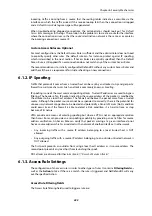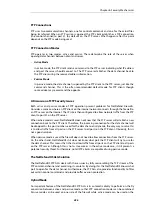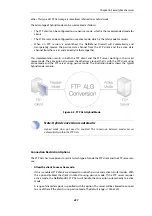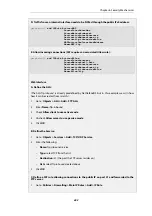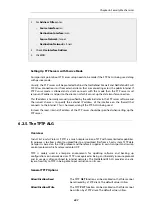
FTP Connections
FTP uses two communication channels, one for control commands and one for the actual files
being transferred. When an FTP session is opened, the FTP client establishes a TCP connection
(the control channel) to port 21 (by default) on the FTP server. What happens after this point
depends on the FTP mode being used.
FTP Connection Modes
FTP operates in two modes:
active
and
passive
. These determine the role of the server when
opening data channels between client and server.
•
Active Mode
In active mode, the FTP client sends a command to the FTP server indicating what IP address
and port the server should connect to. The FTP server establishes the data channel back to
the FTP client using the received address information.
•
Passive Mode
In passive mode, the data channel is opened by the FTP client to the FTP server, just like the
command channel. This is the often recommended default mode for FTP clients though
some advice may recommend the opposite.
A Discussion of FTP Security Issues
Both
active
and
passive
modes of FTP operation present problems for NetDefend Firewalls.
Consider a scenario where an FTP client on the internal network connects through the firewall to
an FTP server on the Internet. The IP rule is then configured to allow network traffic from the FTP
client to port 21 on the FTP server.
When active mode is used, NetDefendOS does not know that the FTP server will establish a new
connection back to the FTP client. Therefore, the incoming connection for the data channel will
be dropped. As the port number used for the data channel is dynamic, the only way to solve this
is to allow traffic from all ports on the FTP server to all ports on the FTP client. Obviously, this is
not a good solution.
When passive mode is used, the firewall does not need to allow connections from the FTP server.
On the other hand, NetDefendOS still does not know what port the FTP client will try to use for
the data channel. This means that it has to allow traffic from all ports on the FTP client to all ports
on the FTP server. Although this is not as insecure as in the active mode case, it still presents a
potential security threat. Furthermore, not all FTP clients are capable of using passive mode.
The NetDefendOS ALG Solution
The NetDefendOS FTP ALG deals with these issues by fully reassembling the TCP stream of the
FTP command channel and examining its contents. By doing this, the NetDefendOS knows what
port to open for the data channel. Furthermore, the FTP ALG also provides functionality to filter
out certain control commands and provide buffer overrun protection.
Hybrid Mode
An important feature of the NetDefendOS FTP ALG is its automatic ability to perform on-the-fly
conversion between active and passive mode so that FTP connection modes can be combined.
Passive mode can be used on one side of the firewall while active mode can be used on the
Chapter 6: Security Mechanisms
436
Summary of Contents for NetDefendOS
Page 30: ...Figure 1 3 Packet Flow Schematic Part III Chapter 1 NetDefendOS Overview 30 ...
Page 32: ...Chapter 1 NetDefendOS Overview 32 ...
Page 144: ...Chapter 2 Management and Maintenance 144 ...
Page 284: ...Chapter 3 Fundamentals 284 ...
Page 392: ...Chapter 4 Routing 392 ...
Page 419: ... Host 2001 DB8 1 MAC 00 90 12 13 14 15 5 Click OK Chapter 5 DHCP Services 419 ...
Page 420: ...Chapter 5 DHCP Services 420 ...
Page 573: ...Chapter 6 Security Mechanisms 573 ...
Page 607: ...Chapter 7 Address Translation 607 ...
Page 666: ...Chapter 8 User Authentication 666 ...
Page 775: ...Chapter 9 VPN 775 ...
Page 819: ...Chapter 10 Traffic Management 819 ...
Page 842: ...Chapter 11 High Availability 842 ...
Page 866: ...Default Enabled Chapter 13 Advanced Settings 866 ...
Page 879: ...Chapter 13 Advanced Settings 879 ...

